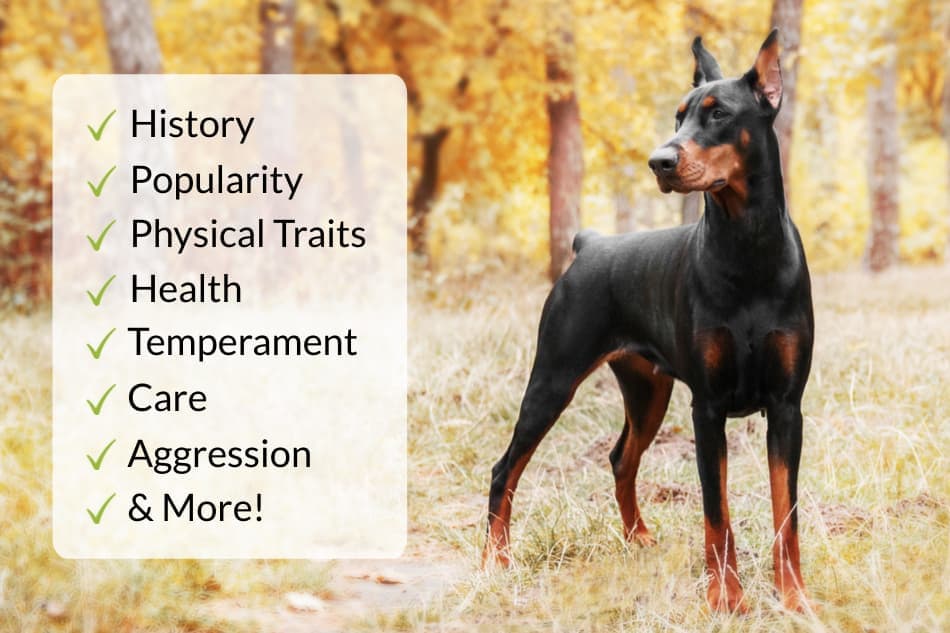
The Doberman Pinscher is a highly intelligent working breed with a rich history who possesses arguably unmatched loyalty to their owners. As a result, the Doberman’s popularity has increased in recent decades and the breed has captured a passionate following of dedicated owners worldwide. Physically, these dogs are capable of some impressive feats and have even contributed to the success of the allies during both the World Wars. The Doberman Pinscher is certainly a very capable dog who has made a great addition to families all around the world for many generations.
Table of Contents
Doberman Pinscher: At-A-Glance
- Height: Males: 26 – 28 inches (66 – 71 cm), Females: 24 – 26 inches (61 – 66 cm)
- Weight: Males: 75 – 100 pounds (34 – 45 kg), Females: 60 – 90 pounds (27 – 41 kg)
- Lifespan: 10 – 13 Years
- Standard Colors: Black & Rust, Red & Rust, Blue & Rust, and Fawn & Rust.
- Non-Standard Colors: White, Melanistic Black, Melanistic Red, Melanistic Blue, and Melanistic Fawn.
- Breed Varieties: American Doberman Pinscher, European Dobermann
- Origin: Germany (1890’s)
- Temperament Traits: Alert, Loyal, Fearless, Intelligent, Obedient
- Health Concerns: Gastric dilatation and volvulus syndrome (GDV or Bloat), hip dysplasia, dilated cardiomyopathy (DCM), chronic active hepatitis (CAH), von Willebrand’s disease (vWD), cervical vertebral instability (Wobbler Syndrome), progressive retinal atrophy (PRA), hypothyroidism, osteosarcoma (bone cancer).
History
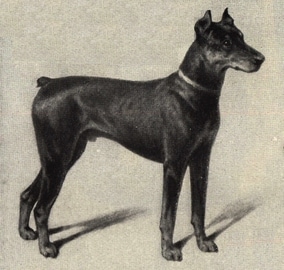
The Doberman Pinscher was created in the 1890s through selective breeding by Karl Friedrich Louis Dobermann, who was a tax collector, night watchman, and the local dog catcher in Apolda, Germany. Imperial Germany at the time was a rough place and as a tax collector, Louis was certainly a target while making his rounds collecting tax money from the citizens. His other job at the time wasn’t much easier, a night watchman was tasked with walking through the town at night, on the watch for thugs who were up to no good. As the local dog catcher, however, Louis had access to a large number of different dog breeds.
Louis began selective breeding to produce an ideal personal protection dog that could accompany him on his rounds through town collecting taxes and performing his duties as a local night watchman. He desired to create a dog with the right combination of intelligence, speed, strength, stamina, ferocity, and unshakable loyalty.
After Louis Dobermann’s death in 1894, the breed that he pioneered was named the “Doberman Pinscher” in his honor. Later, another citizen of Apolda, Germany named Otto Göller became critical in further developing and refining the breed. He became well known as a major promoter of the breed after Louis’s death and was responsible for establishing the official breeding rules for the breed and founding the “National Dobermann Pinscher Club” in Apolda in 1899 along with Oskar Vorwerk, which was the first Dobermann breed club. Otto Göller along with Oskar Vorwerk worked with several other breeders of the Dobermann to establish an official breed standard. By 1900, the breed standard was adopted by the German National Kennel Club and Dobermann breed clubs were founded in many other German towns including Berlin, Mannheim, Frankfort, Hanover, and Hamburg.
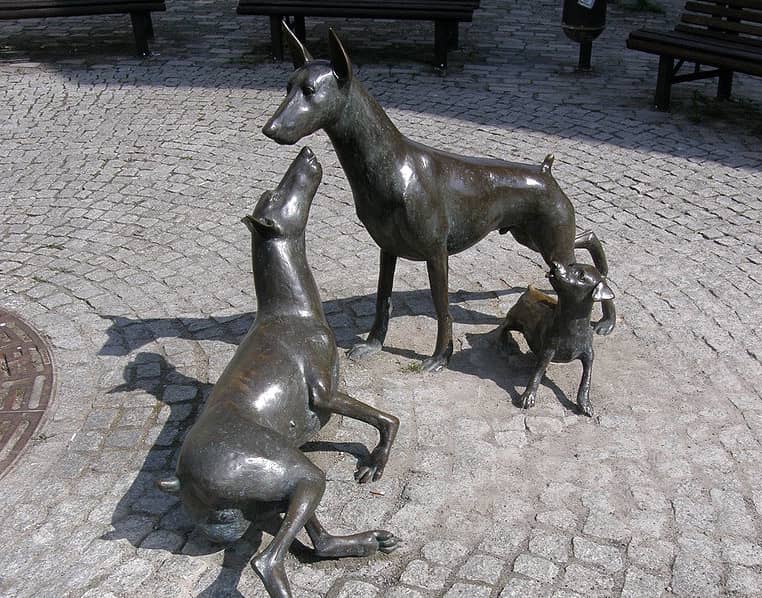
Soon, many Doberman Pinschers were being exported and finding their way to other countries all around the world. The breed was quickly becoming recognized around the world for its highly desirable qualities and there was no turning back—the Dobermann was here to stay.
In 1944 Doberman Pinschers served in World War 2 alongside the U.S. Marine Corps during the battle for Guam. These amazing dogs were recruited with the help of the Doberman Pinscher Club of America (DPCA) and were trained at the War Dog Training Center at Camp Knox in North Carolina.
These dogs were nicknamed “Devil Dogs” and fought fearlessly. During the conflict, 25 of these dogs gave their lives and saved countless servicemen in the process. They conducted over 550 patrols and each dog had specific training to perform their role as either a messenger dog, sentry dog, or scout dog. A memorial currently stands in Guam honoring the 25 Dobermans who gave their lives liberating Guam.
In 1948, Germany dropped the word “Pinscher” from the name as it was argued that the label was not appropriate since the dog is not representative of a pinscher (or terrier). Other countries followed suit and currently only the United States and Canada refer to the breed as the Doberman Pinscher, while the rest of the world refers to the breed as just “Dobermann.” Dobermann is also spelled with a second “n” at the end as this was how the creator of the breed, Louis Dobermann, spelled his last name. For more about Doberman terminology, see my article all about the difference between Doberman and Doberman Pinscher here.
You can read more about the early history of the Doberman Pinscher at this DPCA Masterminds page.
Genetic Origins
The genetic makeup of the Doberman Pinscher is not entirely clear. Louis Doberman didn’t keep records of exactly which breeds of dogs he used in the process of creating the Doberman. However, even after Louis Doberman had produced the first Doberman Pinschers, further refinement of the breed occurred, especially around 1900 when the documented crossing of the bloodline with that of the Greyhound and Manchester Terrier occurred.
Today, experts believe that the following breeds are in the genetic makeup of the modern-day Doberman Pinscher:
- German shepherd
- Rottweiler
- Blue great dane
- German pinscher
- Greyhound
- Weimaraner
- Beauceron
- Black and tan terrier (extinct)
- Manchester Terrier
- Shorthaired shepherd
In order to create the Doberman breed in such a short time, many believe that Louis Dobermann almost certainly would have had to breed his dogs with close relatives of each other.
Experts have established this list of breeds that were likely used in the creation of the Doberman Pinscher from historical records of dogs common in Apolda, Germany at the time of the Doberman’s creation, the genetic makeup of the modern-day Doberman, and with the help of the (sometimes sparse) records that were kept in the early years of the breeds creation.
Currently, there are two variations of the breed. The European Dobermann and the American Doberman Pinscher. The breed has split into these two varieties likely due to many different factors. Most experts cite the strict breeding registration requirements and approval processes in Europe and an emphasis on show dogs in the United States for this split in the breed. While this article focuses on the American Doberman Pinscher, it’s important to mention the differences between the two variations, especially while discussing their genetic makeup.
The European Dobermann
The European Dobermann is a much closer genetic relation to Louis Dobermann’s original creation. These dogs are a compact, muscular working dog. They have thick necks, broad chests, and a somewhat blockier shape to their heads and muzzles. European Dobermanns typically weigh more than their American counterparts.
Heavy regulation in Europe surrounding the breeding of Dobermann’s has helped to keep the breed’s physical traits very close to that described in the FCI Breed Standard.
The American Doberman Pinscher
The American Doberman is a more elegant-looking dog with a smooth sleek long body, a longer neck, and less visible muscle mass than the European variant. They also generally have less pronounced chests, a smoother head shape, and a more slender bone structure in the snout.
The American variant’s physical traits likely developed due to an increased emphasis in the United States on show dogs. Winners of show titles in the U.S. went on to produce more offspring which meant that over time the Doberman became more elegant and sleek in appearance. The ideal traits of the American Doberman Pinscher can be found in the AKC Breed Standard.
For a complete guide on the differences between these two Doberman variants, take a quick look at my article American vs. European Doberman: A Side-by-Side Comparison which includes detailed diagrams of both dogs.
Popularity
The Doberman Pinscher become popular in a relatively short amount of time after its creation near the end of the 19th century and the beginning of the 20th century. The breed saw another explosion in its popularity around the end of World War 2 after the U.S. Marine Corps worked closely with the breed during the war effort, most notably during the Battle of Guam.
In the 1970s the breed’s popularity increased again and Doberman’s found themselves front and center in many facets of popular culture. Dobermans were becoming featured in popular television shows and movies at the time. This lead to an increase in Doberman ownership, especially in the United States, and they became among the top 5 most popular dog breeds during this time.
Many celebrities have owned Dobermans over the years, including John F. Kennedy, Mariah Carey, William Shatner, Rita Hayworth, and Victoria Pendleton. This has also helped the breed climb the popularity ranks.
In Recent Years
More recently, the Doberman has maintained a very high level of popularity, although not quite what it was in the 1970s. Some claim that the dog is due for a resurgence of popularity, but that remains to be seen.
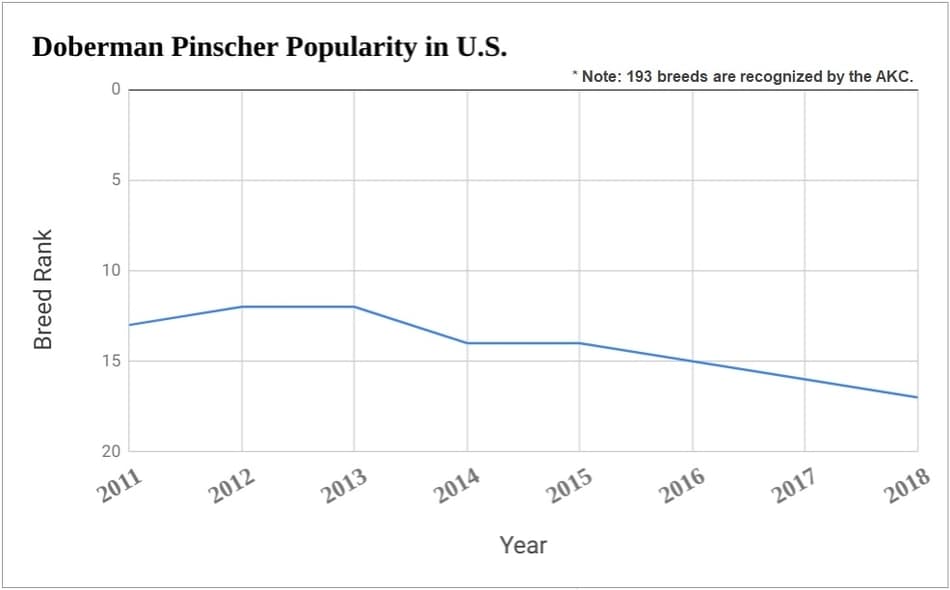
From the graph above, you can see that the Doberman Pinscher’s popularity, although declining slightly in recent years, is still at an impressive level considering that there are currently 193 dog breeds recognized by the AKC. The number of Doberman dog registrations are overall on an upward trend in recent decades and according to the American Kennel Club (AKC), they were the 17th most popular dog breed in 2018.
UPDATE: 2019 Numbers are in and the Doberman is ranked as the 19th most popular dog breed by the AKC. A small decline in popularity from 2018.
The Doberman is also quickly gaining popularity in some major cities, such as Chicago, Illinois and may soon break into the list of top 5 most popular breeds in that city, according to the AKC. Unfortunately, many landlords in large metropolitan areas still categorize the Doberman as a “vicious breed”, despite the overall tame nature of the modern-day Doberman. This means the breed is often banned from many big-city housing communities, which impacts Doberman ownership rates as a result.
Worldwide Popularity
In 2013, a study was conducted by the Federation Cynologique Internationale (FCI) of worldwide popularity figures of 293 different dog breeds in 25 countries around the world. This study was based on the dog registration figures for each of these countries. In total, this survey involved 2,276,864 registered dogs. Of the 293 breeds in this worldwide survey, the Doberman was ranked as the 26th most popular dog breed in the world bringing in 20,941 new Doberman registrations every year (source).
Physical Characteristics
The Doberman Pinscher has many physical traits that make them both an elegant and very physically capable breed. While many consider this to be a large breed of dog, they’re technically classified as a medium-sized dog. They display a toned muscular physique and a proud gait.
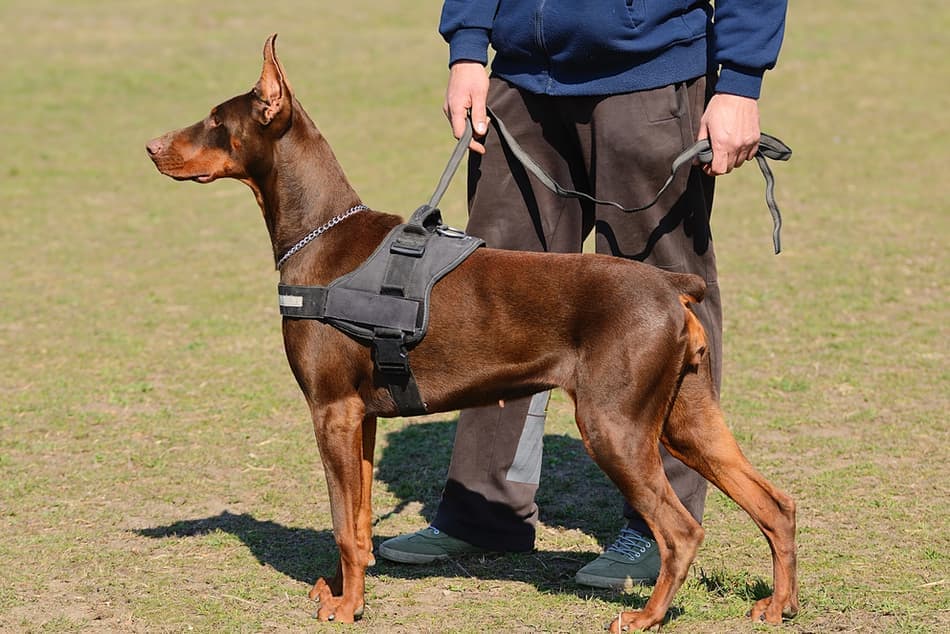
Height
- Males: 26-28 inches
- Females: 24-26 inches
Weight
- Males: 75-100 pounds
- Females: 60-90 pounds
Coat
Smooth, short, thick hairs that lie close together make up a single-layered coat. A second layer, or undercoat, is present around the neck area.
Head
A blunt wedge-shaped head with a long muzzle.
Ears
The ears are usually cropped when the dog is between 7 and 9 weeks of age. The ear cartilage is then trained so that when the cartilage hardens (a natural process as the dog ages), the ears will stand erect. However, many owners opt to leave the ears uncropped. Learn more about Doberman ear cropping here.
Tail
The tail is traditionally docked at the second joint soon after birth. Some owners may opt to keep the long tail. Learn more about tail docking Dobermans here.
Bite
Teeth come together in a scissors bite. There are 22 teeth in the lower jaw and 20 teeth in the upper jaw.
Colors
Black is the most common color, followed by red. Blue and Fawn (Isabella) are also often seen. These variants are all accompanied by rust-colored markings on all four legs, below the tail, chest, throat, snout, and above each eye. Some dogs may have a small white patch on the chest. See All the Colors and Types of the Doberman Pinscher for pictures and information on all known colors.
Health
The Doberman Pinscher breed is susceptible to a number of genetic issues. Reputable breeders in the United States and elsewhere make efforts when selecting breeding pairs to help minimize the chances of passing along many of these genetic disorders.
- Gastric Dilatation and Volvulus Syndrome (GDV or Bloat): Bloat is a very painful condition caused when the dog’s stomach fills with air (or gas) and twists. This twisted stomach cuts off circulation and can be deadly to the dog if not corrected. A few minimally invasive techniques exist to untwist the stomach. However, surgery may ultimately need to be performed. Steps can be taken to help prevent this, however, such as eating smaller easy to digest meals, encouraging slower eating, and refraining from exercise around meal times.
- Hip Dysplasia: Hip dysplasia is a genetic condition that causes the hip joint to form incorrectly causing the ball of the leg and the socket of the hip to not fit tightly together. This can lead to lameness and pain in the hips. Some non-invasive options exist to help manage symptoms (physical therapy, losing weight, and anti-inflammatory medications). Some surgical options may also provide additional relief.
- Dilated Cardiomyopathy (DCM): Also called enlarged heart syndrome, this is a genetic condition that causes the heart muscle to become thicker and larger with time. There are treatments that can be moderately effective at extending life, but DCM is an incurable and terminal disease. See my in-depth breakdown of this serious disease which seems to be affecting more Dobermans here: Doberman Pinscher Dilated Cardiomyopathy (DCM) Simplified.
- Chronic Active Hepatitis (CAH): Chronic Active Hepatitis is inflammation of the liver. This inflammation causes scar tissue to develop in the liver, reducing its function. Copper storage disease is one of the most common causes of CAH in Dobermans. The average age at diagnosis is 6 years, and death typically occurs within 1 to 2 years. Although if caught early enough, medications can often help the dog achieve a full life span. Regular bloodwork is critical for early identification of this disorder.
- von Willebrand’s Disease (vWD): This is a genetic blood clotting disorder that causes excessive bleeding. It’s rarely fatal if managed correctly. Simple tests exist that can be done to determine if your dog has this disorder.
- Cervical Vertebral Instability (Wobbler Syndrome): Wobbler syndrome is a genetic neurological disorder that causes compression of the spinal cord in the neck area. This can lead to lameness in the hind legs, weakness, difficulty with mobility, unsteady gait, or paralysis. This doesn’t usually appear in an affected dog until they’re over the age of 3 years. Symptom management options and surgical options exist to correct the condition.
- Progressive Retinal Atrophy (PRA): Progressive retinal atrophy is an inherited disease that causes degeneration of the cells in the eye causing blindness. PRA is not painful to the dog but blindness can cause additional stress. There is no treatment for this condition.
- Hypothyroidism: This is an inherited condition that causes your dog’s body to produce too much thyroid hormone. It can cause lethargy, depression, weight gain, and mental dullness. A dog diagnosed with hypothyroidism can usually live a full life span with the assistance of medication.
- Degenerative Myelopathy (DM): This is a disorder that affects the dog’s spinal cord and usually develops later in life. It typically starts with lameness in the dog’s rear end, progressing to the rest of the body until the dog is unable to stand or walk. As debilitating as this disorder is, it does not directly cause pain to the dog.
- Osteosarcoma (Bone Cancer): Osteosarcoma is a type of cancerous bone tumor that can begin showing symptoms such as lameness, joint pain, and swelling around the site of the tumor. The cancerous cells usually spread throughout the body making this a terminal illness with little that can be done to mitigate the issue.
- Head Bobbing Syndrome: Also frequently called Episodic Head Tremor Syndrome, Idiopathic Head Tremors, or simply head tremors, this is a common issue with the Doberman breed where the dog will uncontrollibly shake their head side-to-side or up-and-down. It’s thought that this doesn’t cause the dog any discomfort and episodes typically only last for a few minutes. You can learn a lot more in the article Doberman Head Tremors and Head Bobbing Syndrome here.
These are all serious disorders that Dobermans are prone to and many are life-threatening. The best thing you can do to help ensure your dog is not affected is to make sure that you get your dog from a reputable breeder who performs the necessary health and genetic testing.
I wrote an article all about the best places to locate Doberman breeders which provides some great online resources for finding reputable breeders who perform these tests.
TIP
A Doberman’s nose is a great indicator of their overall health. If a Doberman has a dry or cracked nose, something may be wrong. See 10 Reasons Dobermans Can Get a Dry or Cracked Nose for what to look for and how to treat it.
Temperament
The modern-day Doberman possesses a temperament that is much different from its ancestors. Whereas Louis Dobermann’s early dogs were likely fairly aggressive dogs, today the Doberman is a much more mild, family-oriented dog. This is especially true if the dog is well socialized from an early age. However, they still possess great protective instincts and are certainly capable of guard work.
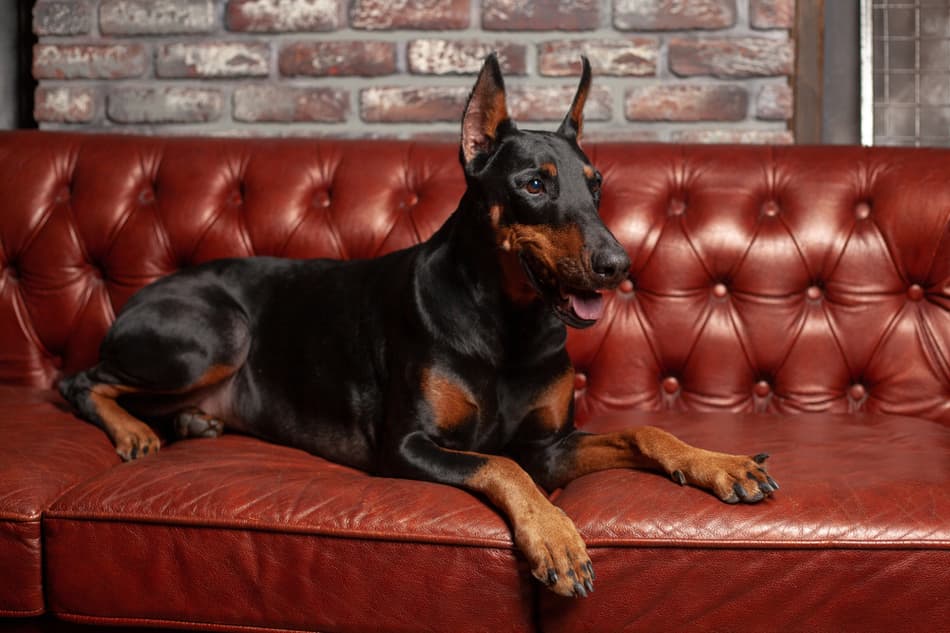
Intelligent
The Doberman Pinscher is consistently ranked among the top most intelligent dog breeds in the world. In the “Hart and Hart” study in 1985, the Doberman was ranked as the most intelligent dog of all breeds. Another study in 1980 ranked the Doberman as the most trainable dog breed in the world. Other studies have consistently put the Doberman among the top five breeds in terms of intelligence.
Calm
These dogs are known for being calm, elegant, and stoic in nature. Not easily phased, they know how to study their surroundings with watchful patience. However, they certainly have a playful and energetic side when they feel comfortable letting loose, making them great for families with active kids. They also require lots of regular exercise to keep them happy.
Obedient
Their high level of intelligence makes these dogs not only highly trainable but also very obedient. They have a strong drive to please their owners which means they tend to listen closely to commands given to them.
Watchful and Alert
Always aware of their surroundings, Dobermans like to keep an eye on everything that’s going on around them. They’re especially focused on their masters and will have a strong desire to stay by their owner’s side if they are in unfamiliar or seemingly dangerous surroundings due to their protective instincts. This is also the reason you’ll almost always find a Doberman sleeping facing the door, especially in new surroundings.
Determined
A high level of determination and drive is present in the Doberman. While this is certainly true for the American Doberman Pinscher, it’s even more noticeable in the European variant. When given a task, they’re committed to carrying it out. This adds to their trainability and makes them great for agility and working dog competitions.
Loyal
The Doberman Pinscher is incredibly loyal and devoted to their families. They will not hesitate to put themselves in harm’s way for the sake of their owners.
Fearless
Most Doberman owners will agree that their dogs are not afraid of any person or animal. This is likely due to their powerful protective instincts. However, when their protective instincts are not engaged, it’s common to find the Doberman expressing their own unique personality by avoiding rain, your vacuum cleaner, or that cardboard box stacked in the corner that might tip over near them.
People Oriented
These dogs are very people-oriented and pay close attention to the emotions and body language of their masters. This helps them with trainability and personal protection work since they can easily sense when their masters are fearful, even if it isn’t obvious to others. They’re known for maintaining eye contact while interacting with people. They also have a tendency to bond strongly to one specific member of the family.
Care
Dobermans are considered to be easy to care for. Their shedding is light and easy to deal with, their coats don’t hold onto dirt and debris the way many other breeds do, and they instinctually prefer to stay clean.
- Feeding: Doberman’s do best with two or three meals spread out evenly throughout the day. If feeding two meals per day, feed one meal in the morning and one in the evening. Generally, 3.5 to 4 cups of dry food per day is ideal. See your food manufacturer for recommended portions for your food specific food.
- Shedding: This breed is considered to be a low to moderate shedder. They have a single layer coat (with the exception of around the neck area) that sheds short thick hairs similar to that of a human eyelash. The hair is easy to sweep up on hardwood or tile floors but may stick into fabrics and be semi-difficult to remove.
- Grooming: Ideally you should brush your Doberman once per week and bathe your Doberman every 6 to 8 weeks. Increased brushing of the coat can be done to help reduce shedding. Brushing of the teeth is optional depending on plaque build-up, but brushing even just once per week will provide significant benefits.
- Exercise: This breed has high exercise requirements and is happiest if provided with regular physical activity. However, significant physical exertion should be limited when the dog is under 18 months of age, especially on hard surfaces like concrete as it risks damage to their joints which are still developing.
- Training: Dobermans are highly intelligent and respond very well to frequent training. It keeps their mind engaged and helps to reduce overall anxiety in the dog. For more help with training your Doberman, see my article How to Train a Doberman: The Complete Guide.
Overall, this is a very clean breed of dog that requires far less grooming and other care than many other breeds. Dobermans don’t like to get dirty and are usually able to keep their home fairly clean. Many owners can get away with bathing their Dobermans only occasionally while still maintaining a shiny, healthy coat.
Aggression
Dobermans are more protective than they are aggressive. This means that they are more likely to react defensively to a situation then they are to act offensively. This is a quality that helps make them great personal protection dogs. The old stereotype of the Doberman as an agressive and dangerous dog is dying as the modern-day Doberman is certainly far more family-oriented than an aggressive “junkyard dog”.
In fact, in a recent study, dog bite fatality statistics were compiled according to the breed of the offending dog over a thirteen-year period. The results showed that between 2005 and 2017, Doberman Pinscher’s accounted for 6 fatalities in the United States—or only about 1.4% of the total number of dog bite-related fatalities during that time. The detailed results of the study are displayed in the table below.
| Breed | Deaths | Percent of Total |
|---|---|---|
| Pit bull | 284 | 65.6% |
| Rottweiler | 45 | 10.4% |
| German shepherd | 20 | 4.6% |
| American bulldog | 15 | 3.5% |
| Mastiff (including bullmastiff) | 14 | 3.2% |
| Husky | 13 | 3% |
| Labrador retriever | 9 | 2.1% |
| Boxer | 7 | 1.6% |
| Doberman pinscher | 6 | 1.4% |
For more information about these statistics and Doberman aggression in general, see my article Are Dobermans Mean, Dangerous, or Overly Aggressive.
Aggression with Other Dogs
There are some aggression issues often noted in Dobermans with other dogs of the same sex who live in the same household. This is more of an issue with two male dogs living together however than two females.
The temperament of the modern-day Doberman, however, is much more conducive to life with other dogs in the same house. Many owners have seen success in raising Dobermans alongside smaller breeds as well. For more information on which specific small dog breeds Dobermans are known to get along with, see my article Dobermans Living with Small Dogs: 12 Tips for Success.
Aggression with Cats
With cats, there doesn’t seem to be a general rule. Some owners report no issues with cats at all, while others have ongoing issues. The one common thread seems to be that if the dog is raised with the cat from a young age, they’re much more likely to get along without problems as an adult. More information is available on my site about how Dobermans get along with cats here. This includes the results of a poll of what Doberman owners who also keep cats in the same home, think about how they get along.
Did You Know? A common myth says that the Doberman brain grows too big for their skulls, causing the dog to randomly become vicious and turn on their owners. See Do Dobermans Turn on Their Owners? Brain vs. Skull Size Myth for more on this.
Video: The Complete Doberman Pinscher Breed Overview
Dobermans as Family Dogs
The modern-day Doberman is a far cry from the vicious dog that they’re often portrayed as in movies and television. Their natural temperamental traits make them ideal for a family environment. In fact, some Doberman owners will argue that you are just as likely to find your Doberman trying to sneak up into your lap while you’re watching television or trying to go to sleep in bed as your Shih Tzu. Yes, Dobermans like to cuddle with their family members at the end of the day.
Since they bond so strongly with their family members, these dogs are also often naturally inclined toward off-leash walking. They don’t like being away from their families and enjoy being a part of the family pack. Many owners say that they only keep their dogs on leashes due to the reactions they might get having them off-leash, and not because they’re worried about their dog running off.
Although leash training a Doberman is also not an impossible task due to their intelligence. See How to Train Your Doberman to Walk on a Leash for more on techniques that work great on Dobermans.
They’re also great with kids and other pets if socialized from a young age. They’re generally calm dogs at the end of the day but can become anxious if they don’t receive daily exercise. This means that they can still get excited and run around with children for hours at a time, which can be great for both the dog and the kids. Dobermans are best fit for active families as they do prefer to stay active during the day.
Dobermans have gained popularity as family dogs due to their good nature, predictable behavior, low shedding concerns, and cleanliness. For more information about Dobermans in a family setting, see my article Are Dobermans Good Family Dogs? The Surprising Truth.
Dobermans as Guard Dogs
The Doberman Pinscher breed was originally created to excel at guard and personal protection work. They have a host of natural instincts such as extreme intelligence, loyalty, fearlessness, watchfulness as well as drive and determination to keep their master’s safe. As a result, they’re consistently rated among the absolute best dog breeds in the world for this type of work.
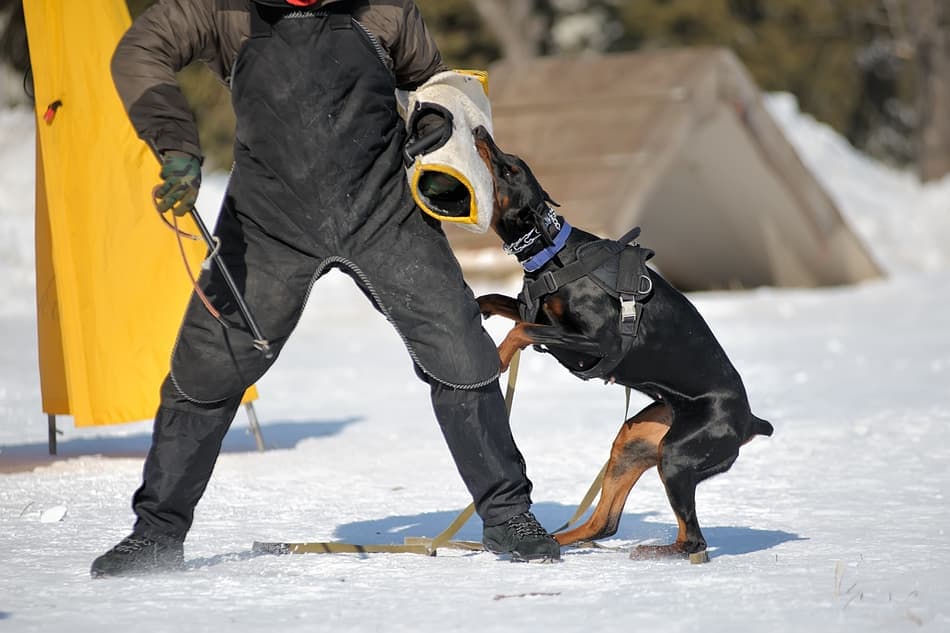
Besides their temperamental traits which make them ideal for guard work, they also have a host of physical traits that make them a formidable force, including:
- Bite Force: 305 PSI
- Bite Type: Scissor bite
- Speed: 40 mph
- Vertical Jump: Up to 6 feet
- Other Physical Characteristics: Muscular build, close to 100 pounds in weight, a large chest area ideal for hitting hard during an attack.
The Doberman also has an amazing sense of smell and is capable of searching a house room-to-room using primarily their nose. This makes these dogs excellent at searching dark, or dimly lit, buildings. Their keen sense of smell allows them to clear rooms incredibly quickly. Only a few seconds of sniffing the air inside a room will alert the dog to the presence (or lack thereof) of any humans hiding inside the room. When Doberman’s search a building, you’ll often see them enter a room, pause, sniff the air for a few seconds, and then continue on.
Dobermans are even known to frequently take action to protect their owners from harm even with no protection training whatsoever. I’ve explored this in much more detail in my article How Even Untrained Dobermans Will Protect Their Owners.
In fact, it’s well known how capable this breed is as guard dogs, and as a result, they very rarely need to take action. Most people realize that if a Doberman is on your property, it’s best to move along if no one’s home.
Dobermans in Other Roles
Due to their impressive list of desirable temperamental traits, Dobermans are also used in many other roles. They can excel at just about any job traditionally reserved for working breed dogs. These include:
- Police K9: Dobermans have been used for decades at police dogs and perform the job exceptionally well due to their trainability, determination and impressive physical capabilities. In recent years, however, some agencies have been moving away from the breed as a police dog due to public perception and their low tolerance to cold temperatures.
- Military: This breed has been used for decades as an exceptional military dog, for many of the same reasons that they make great police dogs. They’ve been used as sentry’s, scouts, messengers, and perimeter protection. During World War 2, they saw extensive action during the battle of Guam where 25 Doberman’s lost their lives protecting U.S. Marine Corps personnel.
- Search and Rescue: Their physical and mental capabilities also make them ideal for search and rescue work and they’re used in this role worldwide. They’re commonly used to assist in recovering evidence, locating human remains, locating missing people, and other important tasks. During the aftermath of the attacks on the Twin Towers in New York on September 11th, 2001 a Doberman Pinscher named Sonny Boy performed extensive work searching the rubble for survivors. He also is credited with helping the New York Fire Department locate the remains of one of their own who perished that day.
- Service Dogs: Besides being incredibly physically capable dogs, Dobermans are also highly trainable and bond very closely to their masters. This makes them ideal as service dogs. They’ve been used successfully as therapy dogs, service dogs, and emotional support animals. I’ve written extensively about Dobermans in these roles in my article Can a Doberman Pinscher Be a Service Dog, including what they’re capable of, how they’re trained, and how to qualify your Doberman for service work.
This breed is truly one of the most versatile dog breeds in existence and they certainly live up to their “working breed” label. Their drive, determination, and focus on the tasks entrusted to them makes them highly desirable in many roles.
The Future of the Breed
The Doberman breed is certainly unique with many positive characteristics that appeal both to the professional use of the breed, as well as use as a family companion. Unfortunately, a prevailing mentality of “only breeding champions” among breeders of the past has led to a surprising lack of diversity in their genetic pool.
This means that serious health concerns are becoming more common among the breed. Although the breed is still a relatively new breed (only first created in the late 1800’s), this breeding mentality has made it increasingly difficult for breeders concerned with producing healthy dogs to be successful. The best way forward for the Doberman breed may be to increase emphasis on health while decreasing the emphasis on “show-perfect” or champion dogs.
However, as word spreads about how wonderful and capable this breed is, it seems only inevitable that the Doberman Pinscher will continue to climb the ranks of popularity and ownership rates. The future is likely to be very bright for the Doberman Pinscher.
Related Questions
Why do Dobermans and Rottweilers look alike? Dobermans and Rottweilers have similar features and markings because they have similar genetics. Experts believe that Louis Dobermann used a local butcher’s Rottweiler during the breeding process that ultimately lead to the creation of the first Dobermans in the late 19th century.

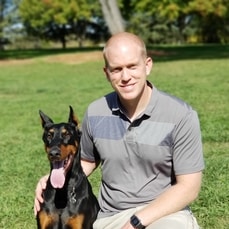
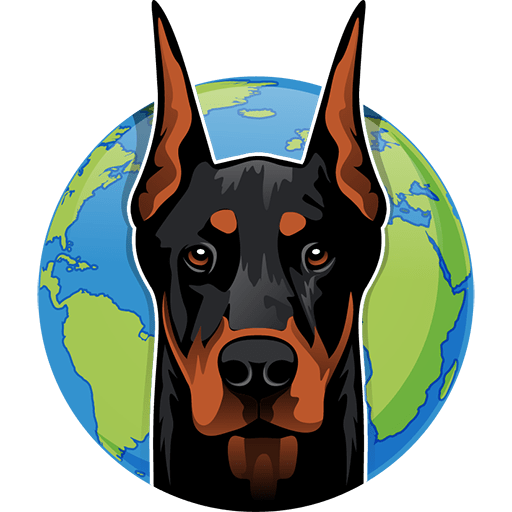
We’re considering getting a Doberman but I’m not sure how I feel about having other people watch her if we go out of town. I understand Dobermans are very loyal to their family. Does that mean she’s dangerous in someone else’s home? We’d bring her with us but probably 1-2 weeks of the year we travel to places we couldn’t take her. I’d love to get your thoughts!
My wife and I traveled quite often and our Doberman stayed with different people in the family from time to time. He did great and was super adaptable to any situation. He has stayed with my parents, my wife’s parents, my brother-in-law and some others. I think the longest trip we had was 3 weeks, which was a bit on the long side… but one-week trips here or there you should be totally fine. So no, they’re definitely not dangerous in someone else’s home. No, at all. Just make sure you socialize your dog a lot when they’re young with different people. Especially with those (like family for example) that they might be staying with in the future. They’re much more likely to not miss a beat and will try and climb in the laps of your family while they’re watching TV to cuddle!